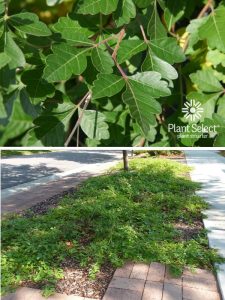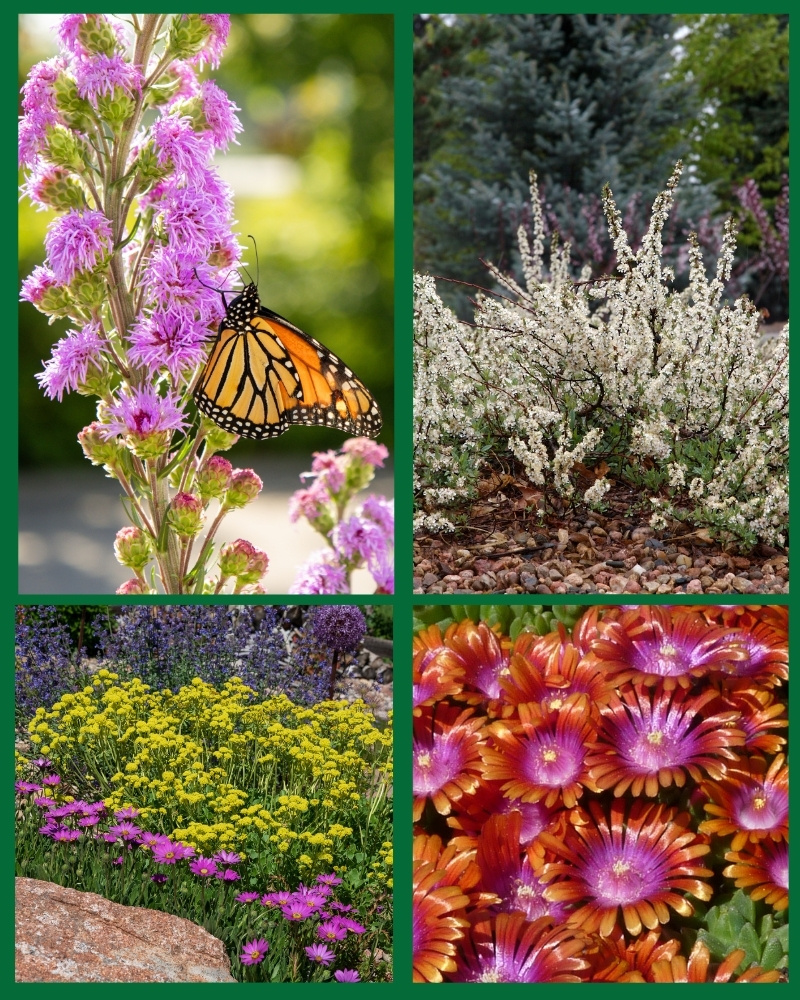Autumn Amber three-leaf sumac: A spreading shrub for urban landscapes
Autumn Amber sumac (Rhus trilobata ‘Autumn Amber’) is a naturally-occurring selection of native Rhus trilobata. Some three-leaf sumacs can reach six feet tall, but Autumn Amber hugs the ground. It was selected from a wild population of Rhus trilobata in New Mexico for its low habit, growing just 10 to 14 inches tall.
This native shrub thrives in the heat and the sun. But in recent years, we’ve discovered that it also grows well in dry shade. It’s highly versatile.
Autumn Amber sumac is a horizontal spreader. Like other three-leaf sumacs, it can swallow up sidewalks and driveways if it gets regular irrigation. Turn off the hoses to this shrub once it’s established unless you have a large area you want to fill. (Autumn Amber sumac doesn’t need supplemental irrigation in monsoon-prone areas that average 12+ inches of moisture per year.)
Rhus trilobata can produce inconspicuous flowers in the spring that are of special value to native bees, according to the Lady Bird Johnson Wildflower Center. Mason bees, in particular, are drawn to the flowers. In the late summer, red berries can appear, feeding birds and wildlife. This shrub also offers habitat.
During summer, Autumn Amber sumac has glossy, bright green leaves.
In the fall, the shrub can glow with red, orange and yellow hues. It tends to produce the best color during years when we have long, slow falls, as well as big variations between daytime and nighttime temps. The color varies, depending on the season.
Autumn Amber sumac is a perfect groundcover shrub that can serve as living mulch, especially if you are tired of your mulch blowing away in the wind. It brings a graceful, vegetative life to sunny and shady spaces, and it thrives in heat and drought. It can soften the hardscape of terraced walls and rock features, and it brings a naturalized look to the landscape.
This is a dependable selection that establishes readily in one season with regular irrigation.
Once established, Autumn Amber will cover significant space (especially if irrigated), so it is a good choice for larger landscapes.
Managing the growth is a simple task if you don’t want to leave it in a natural state. Simply use hand pruners to selectively trim branches to the desired length. This shrub doesn’t grow in a perfect circle. It tends to send out branches. If necessary, trim off the tips of the extending branches, and you’ll get fuller growth and help keep the plant in bounds. To remove winter leaf debris, you can easily spruce up this ground cover shrub in the spring with a leaf blower or a rake.
This is an easy, western native shrub for its durability and its easy-to-grow nature. Autumn Amber Sumac is sure to become a landscape staple for gardens in Colorado, Utah and the Intermountain West.
Rhus trilobata ‘Autumn Amber’
Shrub
Height: 10”-14”
Width: 6’-8’
Blooms: Insignificant to humans (but attractive to native bees)
Sun: Full sun to part shade
Water: Dry to xeric
Hardiness: Zones 4-8
Culture: Sandy soil, loam, well-drained clay
Thanks to Ann Kendall and Ross Shrigley for submitting this piece.




Hi
I am a new gardener and just planted a row of 5 autumn Amber sumac and behind them 4 yellow potentilla in a 34’ long by 6 ‘ -8 ‘ wide space.
My question is what else can I put in between sumac and/or potentilla with blue or purple color keeping with low water care?
Thanks!
Keeping with a native, low water theme try Mojave sage, Colorado desert blue star, Autumn Sapphire, Narbonne blue flax, Windwalker big bluestem or Blue Jazz dwarf pinon pine. Happy planting!
Is Autumn Amber deer resistant? tx.
The Plant Select literature may state that Autumn Amber sumac is deer resistant, but there is plenty of evidence all along the foothills where the deer browse on the larger native Rhus trilobata. In town, the deer have so many other things to eat that they may not eat Autumn Amber sumac.
I have a sloping area in my backyard covered with this plant. Right now two deer are having a great time snacking on it but I really don’t care because this plant grows right back. I call it Mother Nature’s pruning and she’s just saving me some work. This is a great no maintenance ground cover and it never gets watered in my yard.
Thank Ursula! I know a lot of people have this plant grow much larger than expected. One can also slow its growth by not watering it. It also takes dry shade!
chickens? will they eat this? will it make them sick?
Will this plant survive if snow is piled on top of it in the winter?
Yes it will! However, branches may break if there is a snowplow pushing snow onto it, otherwise it will work great!
Are there berries or flowers? Any wildlife uses?
Yes, flowers are important to one species of native bee, but I don’t know the name of that bee.
Do you need male and female plants for flowers and berries?
Yes you do. Interesting note, all Rhus trilobata make a great basket weaving material.
All the Autumn Amber sumacs are clones, and they are male. That means you hopefully have a straight species plant, (which is a much taller plant) that is a female. It’s hard to know if you purchase a male or female straight species from garden centers in the spring because they have not had time to show fruit or not. Best bet would be to buy a straight species in the fall, when you might be able to observe fruit. I’ll get this posted asap!
I want to plant this in our irrigated hell strip, under an immature oak tree. Do I need to remove the grass beforehand?
I would make sure the grass is dead, otherwixe it will grow taller than the sumac and look weedy. I would not remove the grass, just kill it somehow.